
A subwoofer is a loudspeaker designed to reproduce low-pitched audio frequencies, known as bass and sub-bass, that are lower in frequency than those which can be (optimally) generated by a woofer. The typical frequency range that is covered by a subwoofer is about 20–200 Hz for consumer products, below 100 Hz for professional live sound, and below 80 Hz in THX-certified systems. Thus, one or more subwoofers are important for high-quality sound reproduction as they are responsible for the lowest two to three octaves of the ten octaves that are audible. This very low-frequency (VLF) range reproduces the natural fundamental tones of the bass drum, electric bass, double bass, grand piano, contrabassoon, tuba, in addition to thunder, gunshots, explosions, etc.

A loudspeaker is a combination of one or more speaker drivers, an enclosure, and electrical connections. The speaker driver is an electroacoustic transducer that converts an electrical audio signal into a corresponding sound.

A sound reinforcement system is the combination of microphones, signal processors, amplifiers, and loudspeakers in enclosures all controlled by a mixing console that makes live or pre-recorded sounds louder and may also distribute those sounds to a larger or more distant audience. In many situations, a sound reinforcement system is also used to enhance or alter the sound of the sources on the stage, typically by using electronic effects, such as reverb, as opposed to simply amplifying the sources unaltered.

A horn loudspeaker is a loudspeaker or loudspeaker element which uses an acoustic horn to increase the overall efficiency of the driving element(s). A common form (right) consists of a compression driver which produces sound waves with a small metal diaphragm vibrated by an electromagnet, attached to a horn, a flaring duct to conduct the sound waves to the open air. Another type is a woofer driver mounted in a loudspeaker enclosure which is divided by internal partitions to form a zigzag flaring duct which functions as a horn; this type is called a folded horn speaker. The horn serves to improve the coupling efficiency between the speaker driver and the air. The horn can be thought of as an "acoustic transformer" that provides impedance matching between the relatively dense diaphragm material and the less-dense air. The result is greater acoustic output power from a given driver.
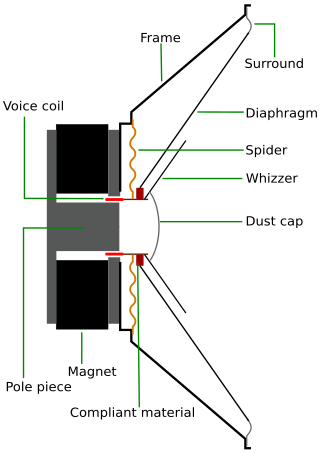
A full-range loudspeaker drive unit is defined as a driver which reproduces as much of the audible frequency range as possible, within the limitations imposed by the physical constraints of a specific design. The frequency range of these drivers is maximized through the use of a whizzer cone and other means. Most single driver systems, such as those in radios, or small computer speaker designs, cannot reproduce all of the audible frequencies or the entire audible audio range.

Acoustic Research was a Cambridge, Massachusetts-based company that manufactured high-end audio equipment. The brand is now owned by VOXX. Acoustic Research was known for the AR-3 series of speaker systems, which used the 12 in (300 mm) acoustic suspension woofer of the AR-1 with newly designed dome mid-range speaker and high-frequency drivers. AR's line of acoustic suspension speakers were the first loudspeakers with relatively flat response, extended bass, wide dispersion, small size, and reasonable cost. The AR Turntable remains a highly sought vinyl record player.
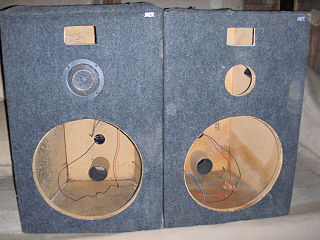
A loudspeaker enclosure or loudspeaker cabinet is an enclosure in which speaker drivers and associated electronic hardware, such as crossover circuits and, in some cases, power amplifiers, are mounted. Enclosures may range in design from simple, homemade DIY rectangular particleboard boxes to very complex, expensive computer-designed hi-fi cabinets that incorporate composite materials, internal baffles, horns, bass reflex ports and acoustic insulation. Loudspeaker enclosures range in size from small "bookshelf" speaker cabinets with 4-inch (10 cm) woofers and small tweeters designed for listening to music with a hi-fi system in a private home to huge, heavy subwoofer enclosures with multiple 18-inch (46 cm) or even 21-inch (53 cm) speakers in huge enclosures which are designed for use in stadium concert sound reinforcement systems for rock music concerts.
LOUD Audio, LLC is a professional audio company based in the United States, operating in the U.S., Canada, and Shenzhen, China. Originally founded as Mackie Designs, Inc., the name was changed to Loud Technologies Inc in 2003 to differentiate its founding subsidiary, mixing console manufacturer Mackie from its eponymous brand name.
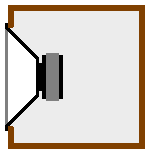
Acoustic suspension is a loudspeaker cabinet design that uses one or more loudspeaker drivers mounted in a sealed box. Acoustic suspension systems reduce bass distortion which can be caused by stiff suspensions required on drivers used for open cabinet designs.

Forsythe Audio Systems was an American manufacturer of professional audio equipment specifically, loudspeakers systems offering extremely high reliability and high fidelity for sound reinforcement professionals. All their designs were by Kenton Forsythe. It was located in Watertown, Massachusetts.
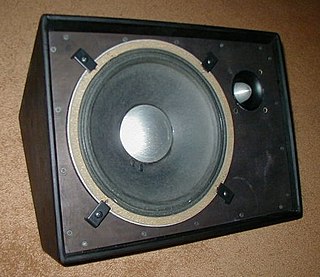
A stage monitor system is a set of performer-facing loudspeakers called monitor speakers, stage monitors, floor monitors, wedges, or foldbacks on stage during live music performances in which a sound reinforcement system is used to amplify a performance for the audience. The monitor system allows musicians to hear themselves and fellow band members clearly.

An audio engineer helps to produce a recording or a live performance, balancing and adjusting sound sources using equalization, dynamics processing and audio effects, mixing, reproduction, and reinforcement of sound. Audio engineers work on the "technical aspect of recording—the placing of microphones, pre-amp knobs, the setting of levels. The physical recording of any project is done by an engineer…"
A coaxial loudspeaker is a loudspeaker system in which the individual driver units radiate sound from the same point or axis. Two general types exist: one is a compact design using two or three speaker drivers, usually in car audio, and the other is a two-way high-power design for professional audio, also known as single-source or dual-concentric loudspeakers. The design is favored for its compactness and behavior as an audio point source.

Smaart is a suite of audio and acoustical measurements and instrumentation software tools introduced in 1996 by JBL's professional audio division. It is designed to help the live sound engineer optimize sound reinforcement systems before public performance and actively monitor acoustical parameters in real time while an audio system is in use. Most earlier analysis systems required specific test signals sent through the sound system, ones that would be unpleasant for the audience to hear. Smaart is a source-independent analyzer and therefore will work effectively with a variety of test signals including speech or music.

David W. Gunness is an American audio engineer, electrical engineer and inventor. He is known for his work on loudspeaker design, especially high-output professional horn loudspeakers for public address, studio, theater, nightclub, concert and touring uses.
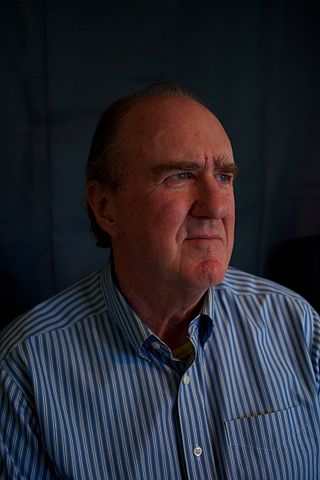
Cliff Henricksen is a musician, inventor and audio technologist. He is self-taught as a musician with a graduate degree in mechanical engineering at Massachusetts Institute of Technology (MIT). Throughout his career Cliff has found innovative ways to apply engineering basics to electro acoustics and to audio technology as it applies to music and in particular to live music performance. He has invented and engineered a wide variety of technologies and products well known in the world of professional audio. Today he balances work in audio and work as a performing musician.

In a loudspeaker, a phase plug, phasing plug or acoustical transformer is a mechanical interface between a speaker driver and the audience. The phase plug extends high frequency response because it guides waves outward toward the listener rather than allowing them to interact destructively near the driver.
Clair Global, or simply Clair, is a professional sound reinforcement and live touring production support company. It was founded by brothers Roy and Gene Clair, who went into business in 1966 after they were asked to bring their sound system on tour with Frankie Valli and the Four Seasons. It is believed they were the first professional sound company to tour with a band. The company formally incorporated in 1970 as Clair Bros. Audio Enterprises, Inc.

Fulcrum Acoustic is an American manufacturer of professional loudspeakers, including permanent-installation loudspeakers, portable loudspeakers, subwoofers, line arrays, stage monitors, and studio reference monitors. Their research and development offices and production facilities are located in Whitinsville, Massachusetts while their administrative offices are in Rochester, NY. Fulcrum Acoustic products are sold through an international distribution network and are deployed in houses of worship, sports venues, hospitality venues, concert halls, music festivals, theaters, and nightclubs.

Kenton "Ken" George Forsythe was an American engineer and professional audio pioneer, known for developing high performance loudspeakers for the sound reinforcement industry.
















